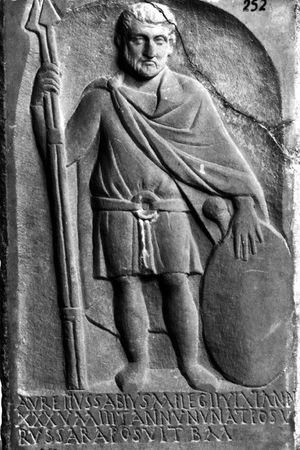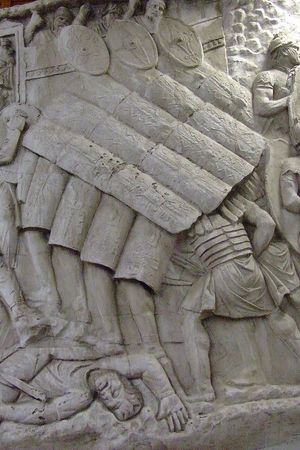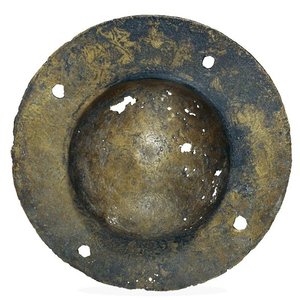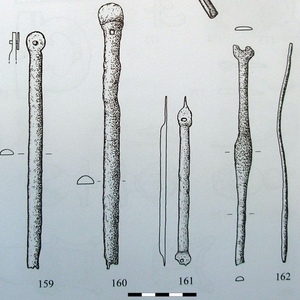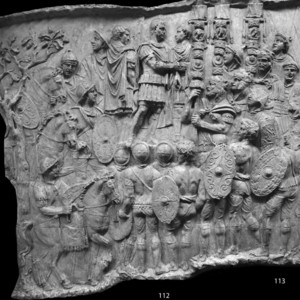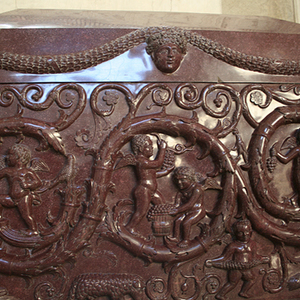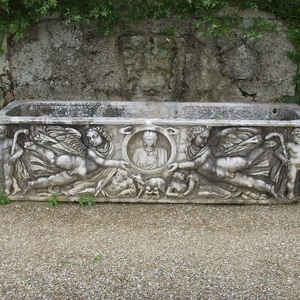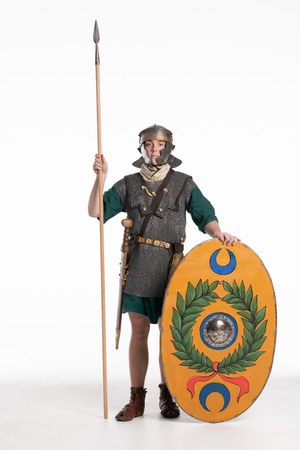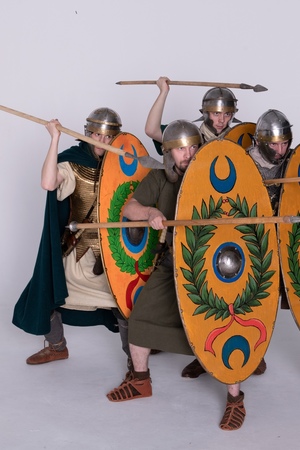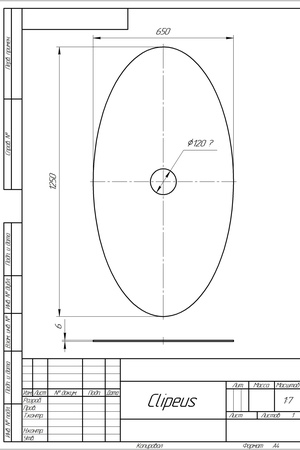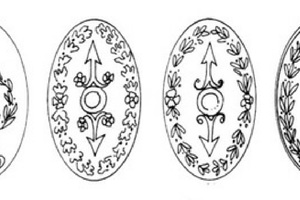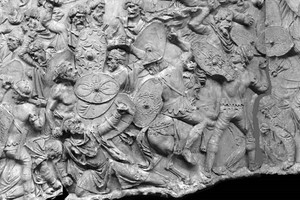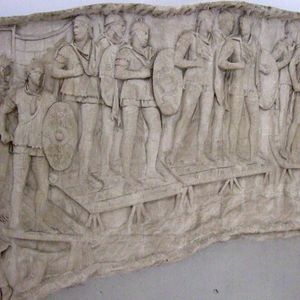Clipeus
Clipeus (Latin: clipeus, clipeum) is a round or oval shield used in the army of Ancient Rome. The name of the shield is believed to be derived from the Ancient Greek word καλύπτω, meaning "to cover." It was primarily used by auxiliaries, such as spearmen and cavalry, while the legionary scutum served as the main shield in the Roman army. However, the clipeus itself appeared much earlier and later outlived the scutum, becoming the main shield of the Roman army until the 5th century CE.
Historical background
The origins of the clipeus can be traced back to the ancient Greek hoplons, which were round shields used by hoplites. The Romans, who also used the phalanx as their main infantry formation until the 4th century BCE, employed similar shields called parma, which had a round shape. However, during the adoption of the manipular tactics by the Romans, the scutum became the main Roman shield, while the parma remained in use by light infantry (velites) and partially by cavalry. It was around this time that the clipeus, an oval shield likely developed from the parma, was introduced and adopted by auxiliary troops (auxilia). There is a version that suggests that the terms "parma" and "clipeus" were interchangeable during the early Republican period and used to refer to the same type of shields. The parma, as a small round shield, continued to be used by the legion's standard bearers (aquilifers), signifers, vexillarii, as well as cornicen and tubicen musicians.
Both the oval clipeus and the round parma remained in use by the Roman army throughout the existence of the Roman state. In the 3rd century CE, clipeus shields gradually started to replace the scutum as the main shield. Discoveries from the Roman fortress of Dura-Europos, dated to the 3rd century CE, indicate a prevalence of round or oval shields rather than scuta. (It is worth noting that the best-preserved scutum was also found in this fortress.) The shields found at the fortress were no longer flat but convex, resembling Greek hoplons. The decoration of the clipeus also became more elaborate, often featuring images of Christian saints. However, among historians, there is a debate about whether the shields found at Dura-Europos should be correctly referred to as parma shields. Nonetheless, the dispute over the correct name for this type of shield existed as early as the Republican period, so it can be argued that both variations are valid.
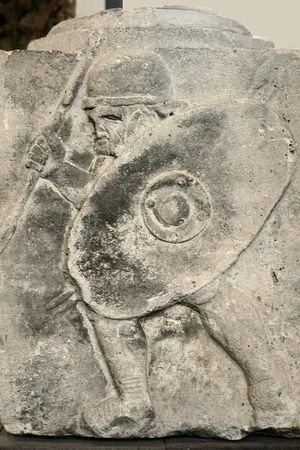 Image of a Roman warrior with a clipeus. Bas-relief of the pedestal of one of the columns that decorated the courtyard in front of the complex of buildings of the headquarters (praetorium and principia) of the citadel of the Roman city of Mogontiac (Latin Mogontiacum, modern. German city of Mainz). "Land Museum", Mainz, Germany. Second half of the first century AD
Image of a Roman warrior with a clipeus. Bas-relief of the pedestal of one of the columns that decorated the courtyard in front of the complex of buildings of the headquarters (praetorium and principia) of the citadel of the Roman city of Mogontiac (Latin Mogontiacum, modern. German city of Mainz). "Land Museum", Mainz, Germany. Second half of the first century ADStructure
The construction of the clipeus was similar to that of the scutum. The base of the clipeus was made of vertically glued planks, which were then covered with canvas or leather on the outer (and sometimes inner) side and framed with a rawhide border. It is worth noting that these clipeus shields were generally taller than the scuta of the late Republic and Empire. The average height of the scutum was around 105-107 cm, whereas the remains of clipeus shields found at Dura-Europos suggest a height of approximately 125 centimeters and a width of 70-80 centimeters at the widest part.
Like the scuta, clipeus shields were also adorned with emblems (digmata), various examples of which can be found on numerous reliefs. These emblems likely served to distinguish auxiliary units.
In the center of the clipeus base, just like the scutum, a circular hole was cut out to accommodate a round metal grip, covered on the outer side with an iron or bronze umbo. In many places where remains of various Roman equipment have been found, it is quite difficult to determine the affiliation of a specific type of handles or umbos to a particular type of shield, whether scutum or clipeus. Moreover, it is highly possible that these parts were manufactured using similar techniques, suggesting that the handles and umbos of these two types of shields were very similar. However, it should be noted that clipeus shields are usually associated with umbos with a round base, while scuta had umbos with square, rectangular, or hexagonal bases.
Imago clipeata
An important factor to mention is the Imago clipeata, a sculptural element also known as a clipeus due to its round shape. In Rome, from the Republican period until the 3rd century BCE, there was a sculptural and pictorial tradition of depicting various mythological or historical figures within a circular frame. This frame could be a simple circular border, an intricate wreath, or any other round object. This element is frequently encountered on reliefs of sarcophagi from the 3rd to 4th century CE.
The origin of this tradition can be traced back to the depictions of military commanders, triumphators, on a small round shield, the clipeus, which was attached to the standard when the commander returned to his homeland in a triumphant march.
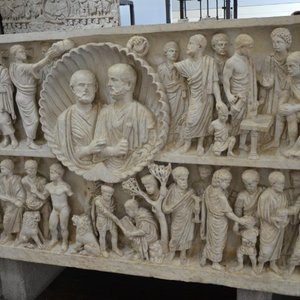 Sarcophagus of Two Brothers, III-IV century A.D. Catacombs near Rome. Preserved in the Pio Cristiano Museum, Rome
Sarcophagus of Two Brothers, III-IV century A.D. Catacombs near Rome. Preserved in the Pio Cristiano Museum, RomeReenactment
In Legio X Fretensis, the reenactment of auxiliary troops is dedicated to the Second Cantabrian Cohort, which, in terms of service, was the closest to the Tenth Legion. For the reconstruction of the auxiliary cohort in our club, clipeus shields are made according to the following pattern: 125 cm in height and 65 cm in width (at the widest part). The decoration consists of a yellow background fabric, and the emblem used is an auxiliary emblem from Trajan's Column. The shield's border is made of brass.
Related topics
Auxiliaries, Shield, Parma, Shield of the dominant era
Literature
- Connolly P. Greece and Rome. Encyclopedia of Military History, Moscow: EKSMO-Press, 2000. 320 p. - 10 000 copies. — ISBN 5-04-005183-2.
- Bishop, M.C.; Coulston, J.C.N. (2009). Roman Military Equipment from the Punic Wars to the Fall of Rome (2nd ed.). Oxford, UK: Oxford Books;
- JAMES CURLE, F.S.A. SCOT., F.S.A. A Roman frontier post and it's people. The fort of Newstead in the Parish of Melrose. Glasgow, MDCCCCXI. Originally published by JAMES MACLEHOSE AND SONS for the Society of Antiquaries of Scotland.
- Hilary & John Travis. Roman Shields: historical development and reconstruction. Amberley Publishing, Gloucestershire, GL5 4EP, 2014.

 Gallery
Gallery






